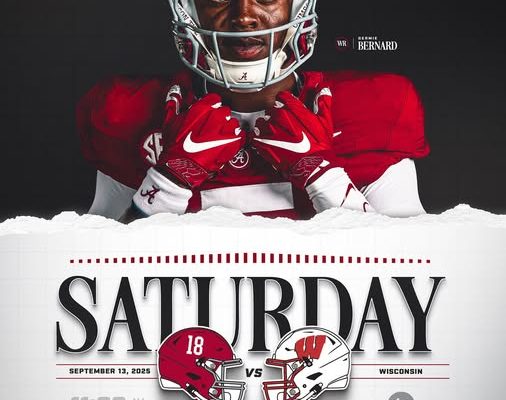The anticipation for the upcoming matchup between Alabama and Winconstein has reached a fever pitch among college football fans, analysts, and even casual observers who recognize that this is more than just a regular-season game. With storied programs on both sides, this contest carries not only the weight of conference standings but also the potential to define legacies and alter careers. When Alabama steps onto the field, expectations are always sky-high. The Crimson Tide has long been synonymous with dominance, consistency, and excellence in college football, a program that has built an almost mythic reputation under its coaching staff and an elite roster of athletes year after year. Winconstein, meanwhile, has steadily been emerging as a powerhouse in its own right, one that refuses to be overshadowed by traditional giants. The combination of these two forces has created a storyline that is compelling, tense, and filled with dramatic possibilities.
Alabama enters this game with a roster that is as talented as it is deep. Every position boasts athletes who have either been highly recruited or have demonstrated exceptional growth and skill during their time in Tuscaloosa. The defensive front alone has the ability to dominate any offensive line in the nation, and when paired with a skilled secondary and a quarterback capable of making plays both in the air and on the ground, the Crimson Tide presents a challenge that few teams are equipped to handle. Moreover, Alabama’s coaching staff has built a system that is resilient and adaptive, one that can adjust mid-game to counteract strategies that opposing teams deploy. This adaptability has become one of Alabama’s trademarks, and it is a factor that Winconstein must carefully plan for if it hopes to come away victorious.
On the other side, Winconstein has earned its reputation through a combination of tactical ingenuity and raw athletic talent. The program has been methodically building a roster that can compete with top-tier teams, blending experienced upperclassmen with promising underclassmen who bring energy and unpredictability to the field. Winconstein’s offensive schemes are designed to be versatile, often keeping defenses off balance with misdirection, play-action passes, and dynamic running backs capable of exploiting small gaps in coverage. Their defense, while not as historically celebrated as Alabama’s, has shown remarkable improvement in recent seasons, demonstrating the ability to pressure the quarterback, shut down the run, and create turnovers that can change the course of a game in an instant.
This matchup carries stakes beyond the typical win-loss record. For Alabama, a victory is expected by many, but anything less than a decisive performance will raise questions about the program’s current trajectory and the effectiveness of its roster in high-pressure situations. For Winconstein, an upset would not only cement the team’s legitimacy as a national contender but could also serve as a springboard for recruiting, national recognition, and long-term program growth. In many ways, this game represents the collision of tradition and ambition, experience and youthful energy, as each program seeks to assert its identity on the national stage.
Beyond the team dynamics, individual players are under intense scrutiny. Alabama’s defensive stars are expected to maintain the high standards that the program is known for, and any lapse in performance could become a talking point in draft discussions or preseason analyses for the following year. Similarly, Winconstein’s quarterbacks and skill players are carrying the hopes of a program eager to prove that they can compete against the nation’s elite. Every pass, every tackle, and every decision on the field is magnified in a game of this magnitude, where careers can be defined or redirected based on a single play or sequence of plays. The psychological pressure is immense, and how players respond under such conditions often separates the good from the great.
One of the compelling aspects of this matchup is the historical context. Alabama’s program has produced countless legends, from celebrated quarterbacks to defensive stalwarts, many of whom have gone on to successful professional careers. These legends were forged not just in regular games but in matchups that demanded excellence against formidable opponents. Winconstein, while younger as a nationally recognized program, is beginning to cultivate its own narrative, creating heroes and stories that fans and commentators will remember for years to come. The convergence of these histories adds layers of intrigue and significance to the game, making every yard gained or lost feel momentous.
The strategies each team employs will be under intense scrutiny. Alabama is known for disciplined execution, often relying on a combination of physicality and precision to dominate opponents. Their offensive line is designed to control the tempo, allowing the quarterback to make calculated decisions and giving running backs the space to exploit defenses. Winconstein, by contrast, has shown a willingness to innovate, using motion, trick plays, and tempo shifts to create opportunities. The interplay between Alabama’s disciplined approach and Winconstein’s creativity is likely to define the flow of the game, with adjustments made on the fly as coaches react to successes and failures on both sides of the ball.
Special teams may also play a pivotal role in determining the outcome. Field position, kickoff returns, and even the occasional fake punt or field goal can swing momentum at critical junctures. In high-stakes matchups like this, the margin for error is slim, and any misstep can be costly. The focus on every detail, from blocking assignments to snap timing, demonstrates how even the smallest components of the game can have outsized impacts on the final result. Coaches on both sides know this, and meticulous preparation will be key.
The atmosphere surrounding the game cannot be understated. Stadiums for such high-profile matchups are electric, filled with fans whose passion and energy amplify the intensity on the field. Media coverage adds another layer of pressure, with every headline, analyst prediction, and social media post shaping public perception. Players are aware that their performance will be dissected long after the final whistle, influencing not just their individual reputations but also the legacy of the programs they represent. The convergence of athletic skill, strategic planning, and fan engagement creates a spectacle that is as psychologically demanding as it is physically challenging.
In terms of potential outcomes, the game could reinforce Alabama’s dominance or signal the rise of Winconstein as a serious national contender. A blowout in favor of Alabama would solidify their status, affirming that their roster, coaching staff, and preparation remain at the pinnacle of college football. A narrow victory or a close loss for Alabama, however, could spark debates about depth, strategy, or the development of young talent. For Winconstein, a win would be transformative, shifting perceptions and elevating the program to new heights. Even a competitive loss could provide valuable experience, building resilience and confidence that will benefit the team in future seasons.
Another layer of interest comes from the potential career implications for individual players. Scouts, analysts, and draft boards closely monitor performances in marquee matchups, often weighing these games more heavily than routine contests. A standout performance against Alabama can dramatically boost a player’s draft stock, while struggles under pressure can raise questions about readiness for the next level. This dynamic adds personal stakes that parallel the team stakes, with athletes motivated not just by pride and tradition but also by tangible opportunities for professional advancement.
The coaching duel is equally compelling. Alabama’s staff has demonstrated a remarkable ability to adapt and innovate while maintaining a foundation of discipline and execution. Winconstein’s coaching team, relatively newer on the national stage, brings fresh ideas, aggressive game planning, and a willingness to take calculated risks. The interplay between coaching philosophies will be a fascinating subplot, with adjustments, counter-adjustments, and strategic gambits potentially determining the outcome as much as player execution. Fans and analysts alike will be watching to see which approach prevails under pressure.
Finally, the broader implications of this game extend beyond the field. College football thrives on narratives, rivalries, and the drama of competition, and games like Alabama versus Winconstein provide a wealth of storylines. They generate discussion, debate, and anticipation that lasts well beyond the final whistle. From a cultural perspective, these matchups serve as touchstones for fans, alumni, and communities, reinforcing identities and creating shared memories that endure across generations. The significance of this game, therefore, is not limited to wins and losses; it is a defining moment that resonates on multiple levels.
In conclusion, the Alabama versus Winconstein matchup is much more than a regular-season contest. It represents a collision of tradition and ambition, skill and strategy, experience and youth. Every aspect of the game—from individual performances to team strategy, from coaching adjustments to fan engagement—contributes to a narrative that could alter careers, define legacies, and influence the trajectory of both programs. While outcomes are uncertain, the stakes are clear, and the anticipation surrounding this contest underscores why it is being hailed as a game with the power to end careers and create legends. As fans prepare to witness this epic showdown, one thing is certain: college football will never be quite the same again, and the stories from this game will be retold for years to come.



